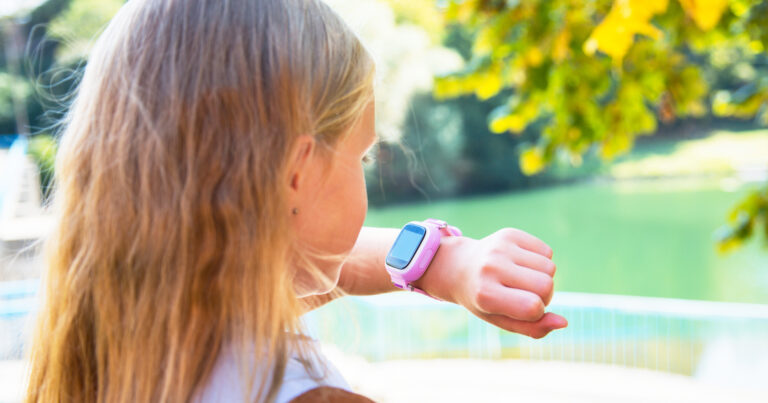GPS technology is well incorporated into our daily lives, whether that be affixing a tracker on your escape artist cat, or using the navigation system in your car. Buying your child a GPS tracker can help give you some extra peace of mind when they’re away from home. Most GPS trackers are wearable or even come in the form of kids' smartwatches and allow you to remotely access pertinent information like your child’s current and past locations, as well as an emergency button.
How do kids’ GPS trackers work?
SafeWise experts have years of firsthand experience testing the products we recommend. Learn how we test and review.
Does your child need a GPS tracker?
GPS trackers can encourage independence in your kids, especially if they’re approaching an age where all they want to do is explore and hang out with their friends. If you have reservations about buying a mobile phone to communicate with your child, a GPS tracker is a great option.
A tracker can help you pinpoint your child’s exact location, especially in the event of an emergency. If they’re the type to miss their stop on the bus or get lost after school, a GPS tracker can help guide them home safely.
GPS trackers don’t have the same features as a mobile phone, but most allow your child to make and accept calls to update you on their whereabouts. Some also have an SOS button, that will send you a notification in case of an emergency. The downside is that most GPS trackers, because of the call or text feature, require a monthly mobile plan.

How they work
Unsurprisingly, kid's GPS trackers use GPS technology, also known as the Global Positioning System. GPS works through a technique called trilateration, which collects signals from satellites to calculate location information. These satellites will send signals to the Earth to be read by GPS devices. The device then logs the exact time it receives the signal and compares it with the time the signal left the satellite. After calculating the difference in distance and measuring this distance to at least four other satellites, the device’s location can be estimated with about 95% accuracy. If you’re craving a more in-depth and technical explanation, have a read of The Mathematics of GPS Receivers.
Active vs passive
There are two types of GPS trackers – active and passive. Active trackers continually update your child’s location data in real time. The kicker with active trackers is they have a higher upfront cost and may ask for a monthly fee.
In comparison, passive trackers focus more on recording and storing the route your kid routinely travels, or how long they stay at a certain point before returning home. It does not report this data in real time and you might even need to download it once your kid returns home.
For a kid's GPS tracker, we’d recommend searching for one that uses active tracking, especially if your main goal is to ensure they return home safe from school or you want an accurate read on their current location.
Active GPS trackers will send a signal to the corresponding smartphone app or web-based dashboard based on:
- Predetermined intervals like every hour or minute
- When requested
- When sent by the wearer
- When crossing a geofence
Geofences
A geofence is a virtual fence – they’re customisable, so you can set one around your child’s school or the park they frequent, for example. If your child starts to wander and crosses the boundaries of the geofence, you’ll get a notification, so you can reign them in or keep track of their exact location.
The downsides
GPS inaccuracy
GPS trackers, like most pieces of technology, are not perfect. There can be limitations and inaccuracy is one of them. In a perfect world, your kid's GPS tracker would tell you exactly where they are at all times with flawless accuracy. However, that's not always the case. Sometimes the tracker can glitch and it might show your child is at the train station instead of the school you just dropped them off at.
Before panicking, do some detective work. Tall buildings and dense trees can obstruct or reflect satellite signals, sending you an inaccurate location. An inaccurate reading might also occur if there are mapping errors within the app, or if the device is being used indoors or in an underground location. Even in ideal locations, GPS readings are usually off by around five metres.
Unauthorised viewing or sharing of location data
Your child’s location history is incredibly important. It shows the route they walk to and from school, what train station (if any) they visit, and the shops, parks, or cafes they frequent with their friends. If this information gets into the wrong hands, it can spell trouble for you and your child’s newfound sense of independence.
While hackers obtaining information from the tracker’s companion app is not common, it is a possibility, and it's always better to be safe than sorry. Make sure you’re diligent about using strong passwords and always use two-factor authentication. Avoid connecting to the app or dashboard when you’re connected to a public Wi-Fi network, and make sure your phone and computer are up to date on antivirus software. Additionally, read the company’s privacy policy thoroughly before purchasing a GPS tracker to understand how your location data is stored and protected.
Final word
It's natural for parents to want to keep an eye on their kid’s whereabouts, especially as they start becoming more independent. Using a GPS tracker can help give you extra peace of mind while your child is away from home, with features like geofencing and live location tracking based on the signals shared by satellites.